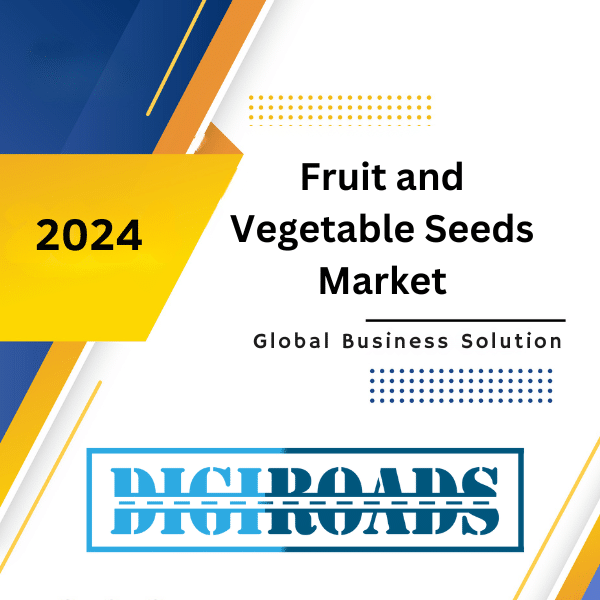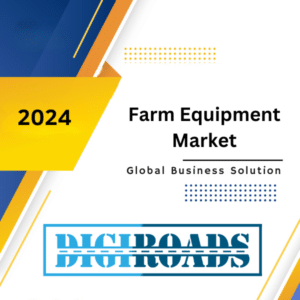Description
Fruit and Vegetable Seeds Market: Opportunity Analysis and Industry Forecast, 2024-2034
Fruit and Vegetable Seeds Market Overview:
The Fruits & Vegetable Seeds market industry is projected to grow from USD 8.0 Billion in 2024 to USD 22.66 Billion by 2034, exhibiting a compound annual growth rate (CAGR) of 8.34% during the forecast period (2024 – 2034).
The fruit and vegetable seeds market is a crucial segment of the agricultural industry, providing the foundation for fruit and vegetable production worldwide. It encompasses seeds for a wide variety of fruits and vegetables, including tomatoes, peppers, cucumbers, lettuce, apples, oranges, and many others.
Key factors driving the growth of the fruit and vegetable seeds market include:
- Increasing Demand for Healthy Food: Growing consumer awareness about the health benefits of fruits and vegetables is driving demand for a diverse range of high-quality produce.
- Population Growth: The expanding global population necessitates higher food production, leading to increased demand for fruit and vegetable seeds to meet dietary needs.
- Changing Dietary Preferences: Shifts towards healthier diets, vegetarianism, and plant-based eating drive demand for a greater variety of fruits and vegetables.
- Technological Advancements: Advances in seed breeding technologies, including hybridization, genetic modification, and marker-assisted selection, improve crop yields, disease resistance, and quality.
- Climate Change: Climate variability and extreme weather events necessitate the development of seeds with improved resilience to drought, heat, and diseases.
- Urbanization: Growing urban populations lead to increased demand for fresh produce, driving the need for seeds suitable for urban farming and greenhouse cultivation.
Geographically, the fruit and vegetable seeds market is influenced by factors such as climate, agricultural practices, and dietary preferences. North America, Europe, and Asia Pacific are key regions for fruit and vegetable seed production and consumption.
Overall, the fruit and vegetable seeds market is expected to continue growing as global food demand rises, and consumers increasingly prioritize health and sustainability in their food choices. Innovation in seed technology and breeding will play a crucial role in meeting these evolving needs and ensuring a resilient food supply.
Fruit and Vegetable Seeds Market – Report Coverage:
The “ Fruit and Vegetable Seeds Market Report – Forecast (2024-2034)” by Digiroads Consulting, covers an in-depth analysis of the following segments in Market.
| Attribute | Segment |
| By Breeding Technology |
|
| By Crop Family |
|
| By Category |
|
| By Location |
|
Recent Developments :
- Focus on Disease-Resistant and High-Yield Varieties: Seed companies are increasingly investing in research and development to create new fruit and vegetable seed varieties with improved disease resistance and higher yield potential. This helps farmers minimize crop losses and maximize their harvests.
- Growing Demand for Organic Seeds: The rising popularity of organic farming practices is driving demand for organic fruit and vegetable seeds. These seeds are produced without synthetic fertilizers or pesticides, catering to the growing consumer preference for organic produce.
- Advancements in Seed Technologies: Developments in seed coating technologies and pelleting techniques are improving seed germination rates, nutrient uptake efficiency, and overall plant establishment.
Examples of Recent Developments:
- April 2024: Syngenta, a major seed company, announced the launch of a new tomato seed variety with exceptional resistance to a common fungal disease, helping tomato growers reduce crop losses.
- March 2024: Bayer, another major seed company, introduced a new line of organic carrot seeds specifically developed for organic farmers, catering to the growing demand for organic vegetables.
These developments highlight the focus on innovation and cater to the evolving needs of the market. Seed companies are striving to create improved seed varieties that offer:
- Enhanced Disease Resistance: Reducing reliance on chemical controls and promoting sustainable farming practices.
- Higher Yields: Maximizing food production and contributing to global food security.
- Organic Options: Meeting the growing consumer demand for organic produce.
- Improved Seed Technologies: Enhancing germination rates, plant establishment, and overall crop performance.
The Fruit and Vegetable Seeds Market is expected to continue growing due to the rising global population, increasing demand for fresh produce, and the growing focus on sustainable agriculture practices.
Crop Protection Chemicals Market Dynamics:
Growth Drivers:
- Rising Global Population: The ever-increasing global population necessitates higher crop yields to meet food demands. Crop protection chemicals play a critical role in minimizing crop losses from pests, diseases, and weeds, thus maximizing yields.
- Climate Change Impact: Climate change disrupts weather patterns and promotes the emergence of new pests and diseases. Crop protection chemicals become essential tools for farmers to adapt to these challenges and safeguard their crops.
Shifting Trends and Sustainability Concerns:
- Focus on Sustainable Solutions: Growing environmental concerns and consumer preferences for sustainable agriculture are driving demand for eco-friendly alternatives. This includes:
- Biopesticides and Biostimulants: These offer a more eco-friendly approach to pest control and promote plant health and stress tolerance.
- Precision Agriculture Integration: Advancements in precision agriculture technologies allow for targeted application of chemicals, reducing waste and minimizing environmental impact.
Regulatory Landscape and Challenges:
- Stringent Regulations: Regulatory bodies are enforcing stricter regulations on the use of crop protection chemicals to minimize environmental and health risks. This necessitates the development of safer and more targeted solutions.
- Pesticide Resistance: The emergence of pest resistance to existing chemicals is a continuous challenge. This necessitates research and development of novel chemistries with new modes of action to combat evolving threats.
The Future of the Market:
The future of the crop protection chemicals market hinges on its ability to achieve a balance between:
- Effectiveness: Developing potent solutions to control pests, diseases, and weeds and ensure food security.
- Sustainability: Minimizing environmental impact through innovations in biopesticides, biostimulants, and targeted application methods.
- Regulatory Compliance: Adapting to evolving regulations and ensuring the safety of both agricultural products and the environment.
Key Market Players:
Product/Service launches, approvals, patents and events, acquisitions, partnerships and collaborations are key strategies adopted by players in the Crop Protection Chemicals Market. The top 10 companies in this industry are listed below:
- Corteva Agriscience
- KWS SAAT SE & Co.
- DLF Seeds & Science
- Invivo
- Royal Barenbrug Group
- Liquid Colours (Pty) Ltd.
- KALO
- IFC Solutions
- TAKII & CO., LTD.
- Mahindra Group
- Rijk Zwaan Zaadteelt En Zaadhandel B.V
- Western Bio Vegetable Seeds Ltd
- MahycoSyngenta Crop Protection AG
- Groupe Limagrain Holding
- Sakata Seed Group
- Advanta Limited
Key Benefits For Stakeholders:
- Farmers:
-
-
- Increased Yield: High-quality seeds lead to higher yields of fruits and vegetables, improving farm productivity and profitability.
- Crop Quality: Improved seed varieties result in better-quality produce, enhancing marketability and consumer satisfaction.
- Disease Resistance: Disease-resistant seeds reduce the risk of crop losses due to pests and diseases, minimizing the need for chemical interventions.
- Environmental Sustainability: Certain seeds are bred to require fewer inputs like water and fertilizers, promoting sustainable farming practices.
-
- Seed Producers:
-
-
- Market Growth: Growing demand for fruit and vegetable seeds creates market opportunities and drives revenue growth.
- Innovation: Seed producers invest in research and development to develop new and improved seed varieties, staying competitive in the market.
- Global Reach: Seed producers can expand their market reach by supplying seeds to diverse geographic regions, meeting the needs of farmers worldwide.
-
- Suppliers:
-
-
- Diverse Product Offerings: Suppliers benefit from offering a wide range of fruit and vegetable seeds, catering to different farming needs and preferences.
- Partnerships and Collaborations: Collaborating with seed producers and farmers to provide technical support, education, and logistics services enhances the value proposition for suppliers.
- Revenue Growth: Increased demand for fruit and vegetable seeds translates into revenue growth opportunities for suppliers as demand for these products rises.
-
- Consumers:
-
- Access to Nutritious Food: High-quality fruit and vegetable seeds contribute to the production of nutritious and healthy food, meeting consumer demand for fresh produce.
- Variety and Diversity: A wide range of seed varieties enables consumers to access diverse fruits and vegetables, supporting dietary diversity and culinary preferences.
- Food Security: Reliable seed supply ensures a stable food supply, contributing to food security for consumers.
We have studied the Fruit and Vegetable Seeds Market in 360 degrees via. both primary & secondary research methodologies. This helped us in building an understanding of the current market dynamics, supply-demand gap, pricing trends, product preferences, consumer patterns & so on. The findings were further validated through primary research with industry experts & opinion leaders across countries. The data is further compiled & validated through various market estimation & data validation methodologies. Further, we also have our in-house data forecasting model to predict market growth up to 2034.
Contact us for any inquiry.
Table of Contents
- INTRODUCTION
1.1 Study Assumptions & Market Definition
1.2 Scope of the Study
- RESEARCH METHODOLOGY
- EXECUTIVE SUMMARY
- MARKET DYNAMICS
4.1 Market Overview
4.2 Market Drivers
4.3 Market Restraints
4.4 Porter’s Five Forces Analysis
4.4.1 Bargaining Power of Suppliers
4.4.2 Bargaining Power of Buyers
4.4.3 Threat of New Entrants
4.4.4 Threat of Substitute Products
4.4.5 Intensity of Competitive Rivalry
- MARKET SEGMENTATION
- By Breeding Technology:
-
-
- Hybrids
- Open Pollinated Varieties & Hybrid Derivatives
-
- By Crop Family :
-
-
- Brassica
- Cucurbits
- Solanaceae
- Amaryllidaceae
- Citrus Family
- others
-
- By Category :
-
-
- Organic
- Conventional
-
- By Location:
-
- North, South America
- Canada
- Europe
- Asia-Pacific
- Rest of the World
- COMPETITIVE LANDSCAPE
6.1 Most Adopted Strategies
6.2 Market Share Analysis
6.3 Company Profiles
- Bayer AG (Germany)
- Corteva Agriscience
- KWS SAAT SE & Co.
- DLF Seeds & Science
- Invivo
- Royal Barenbrug Group
- Liquid Colours (Pty) Ltd.
- KALO
- IFC Solutions
- TAKII & CO., LTD.
- Mahindra Group
- Rijk Zwaan Zaadteelt En Zaadhandel B.V
- Western Bio Vegetable Seeds Ltd
- MahycoSyngenta Crop Protection AG
- Groupe Limagrain Holding
- Sakata Seed Group
- Advanta Limited
- MARKET OPPORTUNITIES AND FUTURE TRENDS





